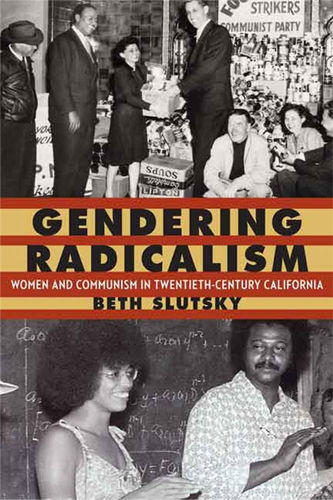
The history of American communism, while contested, is a central component of 20th-century U.S. history. Arguably, we cannot write about 20th-century U.S. history without writing about the Communist Party. Similarly, we cannot write about 20th-century California without writing about the California Communist Party – or the three generations of women leaders who led the California CP from its birth until the collapse of the Soviet Union.
Beth Slutsky’s new book Gendering Radicalism: Women and Communism in Twentieth-Century California does just that. By focusing on the lives of three remarkable women communists, their trials and tribulations, the victories and defeats, Slutsky places their lives squarely within the context of the times. She not only tells their story. She tells the party’s story – as well as the story of the broader movements for social and economic justice, of which the party was a key component.
Slutsky first focuses on Charlotte Anita Whitney (1867-1955), a well-to-do suffragist, women’s rights advocate, socialist and – eventually – founding member of the Communist Party USA.
In 1919, at the age of 52, just weeks after officially becoming a communist, Whitney was thrown in jail for advocating for racial equality, for “a square deal for Negroes by means of the orderly process of the law.” Speaking out against racist violence, as seen through the “dramatic backdrop” of the first Red Scare in the years immediately following World War I translated into “teaching violence; advocating violence; justifying violence; committing violence; and organizing people to advocate, teach, aid, and abet criminal syndicalism.”
As Slutsky put it, “Ironically, on the day Whitney spoke out against lynching…she herself was indicted for [allegedly] advocating violence against the government.” After an immense, prolonged grassroots campaign for free speech, California’s governor “bowed to pressure” and pardoned Whitney in the spring of 1927.
After her pardon Whitney continued as a leading communist. In 1934, at the age of sixty-nine, she ran for state treasurer on the Communist Party ticket, taking 100,820 votes, “more than double the number of votes of any other [Calif.] Communist Party member in that election.” At this time the California CP had about 4000 dues-paying members, as well as tens of thousands of supporters, union and community allies, evidenced by Whitney’s impressive electoral results.
The second woman communist Slutsky focuses on is Dorothy Ray Healey (1914-2006), who joined the Young Communist League in the late 1920s. Healey, an organizer with the party-led Cannery and Agricultural Workers’ Industrial Union, organized “several large strikes,” primarily among Mexican and Mexican American lettuce workers.
During the spring of 1934, Healey – like her comrade Whitney 15 years earlier – confronted the prospect of prolonged jail time. As a union organizer and communist, she also knew that her strike activity placed her on the front lines of the class struggle. She received death threats, and “at one point learned of bounties placed on her head.” Due to her leadership, in 1938 the party-led United Cannery, Agricultural, Packing and Allied Workers’ of America, the seventh-largest CIO affiliate, elected her to serve as international vice president.
According to Slutsky, the union “chose her based on her reputation [as a fearless organizer] but also because she was a woman. Thus, her gender became a strategy to organize the union in important ways,” heretofore ignored by the lily-white, male-dominated, anti-communist AFL.
Further, Slutsky highlights the gendering of opportunity, as “The Party and the union…facilitated greater workplace and leadership opportunities for her…. Clearly, the political [CP] and union work provided Healey with opportunities for professional advancement that would have been nearly impossible to find elsewhere in the 1930s. At a time when most unions excluded female members and leaders and mainstream political parties reluctantly accepted token female representation, Healey embraced the professional feminist identity that labor [and party] activity afforded her.”
By 1940, Healey had been appointed to serve as California’s deputy labor commissioner, where “she held hearings on labor code violations and visited workplaces to inspect health and safety conditions.”
As Slutsky writes, Healey’s job as commissioner “made the ideals of the Popular Front come to life.” Healey was undoubtedly fond of the job. She would later recall: “I was officially entrusted with the authority to enforce the state’s quite progressive labor code. I was given a huge police badge, with the authority to arrest employers – they were the only people I could arrest.”
During the late 1940s and early 1950s, Healey was called before the House Un-American Activities Committee, targeted and harassed. Later in life she continued to build broad-based labor-community alliances, and helped to mentor a new generation of party leaders who would emerge as the 1960s and ’70s era’s student-led, anti-war and civil rights movements became the focus of party work.
Healey would eventually leave the party in 1973, declaring: “My hatred of capitalism which degrades and debases all humans is as intense now as it was when I joined the Young Communist League in 1928. I remain a communist, as I have been all my life, albeit without a Party.”
Before she left, however, Healey “won the admiration of the next generation of activists…[and] sought to identify with students who were coming of age through the free speech movement.”
It was Healey who recruited Kendra Harris Alexander (1946-1993), the final woman communist leader discussed in Gendering Radicalism.
According to Slutsky, “Alexander represented a new generation of Communist Party members and leaders who came of age during the Cold War, became politicized by their participation in the civil rights movement, but then quickly moved on to the Communist Party.”
Further, Alexander exemplified a “much different” CP, an organization “younger, representative of different class and educational levels, committed to multiple movements, and less obedient to the Soviet Union….”
As a CORE (Committee On Racial Equality) and W.E.B. Du Bois club member, Alexander fought against Jim Crow, lynch law, and for voter registration. By 1966 she had joined the CPUSA, and helped to bridge the student-based New Left and the working class, African American-based Old Left, which was primarily allied to the CPUSA. By the early 1970s Alexander would become the coordinator of the National United Committee to Free Angela Davis, her good friend and fellow communist, who had been imprisoned on trumped-up charges of murder.
Alexander would remain a party staple throughout California’s left and progressive movements until spring 1992, when she left the party. Tragically, she would perish in a house fire just one year later.
Slutsky’s Gendering Radicalism is a good read. Whitney, Healy and Alexander’s stories deserve to be told and retold, as their stories are in many ways also the stories of the California Communist Party. By highlighting these courageous lives, Slutsky humanizes the party. She paints a nuanced picture of an organization and its individual members deeply rooted in the American radical tradition, warts and all.
University of Nebraska Press, 2015, 259 pages










